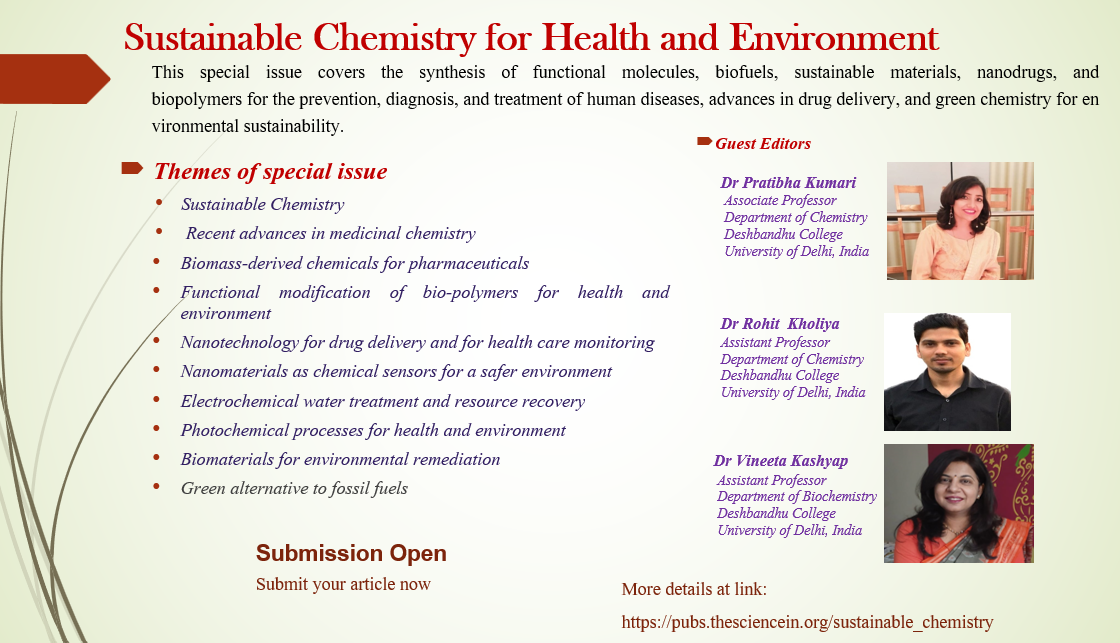A special issue on Sustainable Chemistry covering the medicinal chemistry, green synthesis, biomass derived chemicals, biopolymer for health, nanotechnology, chemical sensors, photochemical reactions, green fuels, natural products, environmental chemistry and allied chemical sciences advances towards sustainable future.
The Department of Chemistry, Deshabndhu College, University of Delhi, India, in association with Augusta University, USA; Indian Society of Chemists & Biologists (ISCB) and the Indian Association of Solid-State Chemists and Allied Scientists (ISCAS) is organising a three-day International Conference on “Integrative Chemical Science for Health and Environment” on 6-8 October 2023. The conference aims to promote scientific network, research and collaboration among experts from all over the world as well as industry personnel to showcase their products. This event enables the environmentalist, health experts, academicians, researchers, and students to present latest developments, trends, and solutions for addressing the issues of good health and a clean environment.
Rising greenhouse gas emissions, as well as an increased carbon footprint as a result of human-caused activities including land usage, deforestation, biomass burning, and agricultural operations, are creating catastrophic climate change. For decades, chemists and biochemists have worked together to address the critical issue of global warming. To reduce the use of fossil fuels and improve air and land pollution, researchers must develop new alternative chemist technologies that are cost-effective, safe, cleaner, and replenishable, such as renewable energy sources, biofuels, and functionally modified chemicals/nanomaterials. Nanotechnology is one of the most promising technologies for fostering sustainable development by addressing issues such as human health, water treatment, climate change, soil remediation, and environmental problems.
This issue will cover recent trends in chemical science and nanobiotechnology that aid in the diagnosis of infectious diseases through the use of new drugs and delivery vehicles, high-resolution biosensors/nanodevices for rapid diagnosis, and artificial intelligence to treat people living in rural areas who are infected with viral diseases such as COVID-19. This issue will also take a close look at recent technological developments that solve various challenges connected to the isolation and characterization of natural products to be used as drug leads for tackling important topics such as antibiotic resistance.
Themes of special issue
- Recent advances in medicinal chemistry
- Green synthesis for health and environment
- Biomass-derived chemicals for pharmaceuticals
- Functional modification of bio-polymers for health and environment
- Nanotechnology for drug delivery and for health care monitoring
- Nanomaterials as chemical sensors for a safer environment
- Electrochemical water treatment and resource recovery
- Photochemical processes for health and environment
- Biomaterials for environmental remediation
- Sustainable Chemistry
- Green alternative to fossil fuels
- Functional molecules/nanomaterials for catalysis
- Natural product synthesis
Guest Editors
Dr Pratibha Kumari
Associate Professor
Department of Chemistry
Deshbandhu College
University of Delhi, India
Dr Rohit Kholiya
Assistant Professor
Department of Chemistry
Deshbandhu College
University of Delhi, India
Dr Vineeta Kashyap
Assistant Professor
Department of Biochemistry
Deshbandhu College
University of Delhi, India
Date Schedule
Article Submission: 20-Feb-2024
Issue Completion: 30-April-2024
Submission
Authors need to submit their articles to guest editors/conference secretariat for preliminary evaluation and peer -reviewing. Final accepted article will have to be submitted on (the recommended) respective journal site).
Participating Journals
Chemical Biology Letters https://pubs.thesciencein.org/journal/index.php/cbl
Journal of Molecular Chemistry https://pubs.thesciencein.org/journal/index.php/jmc
Journal of Materials NanoScience https://pubs.thesciencein.org/journal/index.php/jmns
Applied NanoMedicine https://pubs.thesciencein.org/journal/index.php/nanomed
